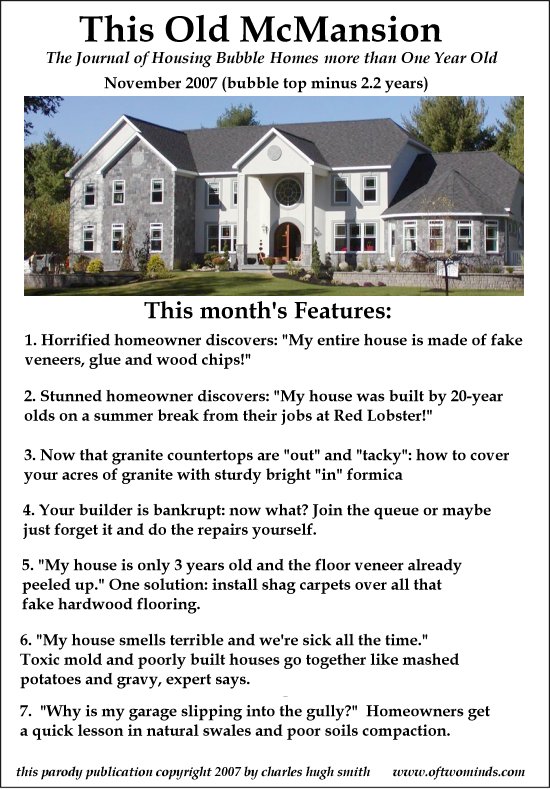

|
| weblog/wEssays archives | home | |
|
This Old McMansion (November 28, 2007) I'd like to introduce a new housing journal for homeowners of shoddily constructed McMansions: 
Don't get me wrong: I'm not making light of the problems faced by many owners of slapped-together bubble-era homes. I am simply noting the potential problems I see as a former builder. 1. Modern materials are vulnerable to rapid failure if improperly installed. If you've owned old houses--and by that I mean 50 years or older--you've probably seen how ordinary solid wood holds up to quite a bit of abuse. You would be hard-pressed to seriously damage solid 3/4-inch oak flooring, which was common even in inexpensive houses and apartments up through the early 1950s. Not so modern-day thin veneer "hardwood flooring." Delamination, faulty installation, animal urine, water damage, deep scratches--any of these can spell the end of modern veneer. The same vulnerabilities to faulty installation and damage are present in brick or stone veneers as well as veneer siding and cabinetry. While the lumber industry has shown that "engineered materials" like wafer-board (such as OSB, oriented strand board) are strong, the long-term durability of glue-and-wood-chips is still an open question. Judging by what happens to chip-board and wafer-board that's been left out in the weather, you have to wonder how well these products hold up once water is present. 2. This means modern homes are especially vulnerable to poor workmanship. In the old days of tar paper and solid wood siding or thickly-applied plaster, the robustness of the basic materials often compensated for small flaws in the workmanship. In an old sash window, layers of solid material worked to keep rainwater from leaking into the wall. Modern waterproofing like Tyvec works extremely well when properly installed, but the flimsiness and vulnerabilities of the modern siding or stucco exteriors don't provide much protection. If the stucco or pressed-wood siding is installed poorly, the Tyvek better be perfect--or the house will leak. Whereas solid wood and thick plaster are water-resistant (yes, they will suffer damage from permanent water presence via plumbing leaks and the like), modern materials like gypsum board and particle board are essentially sponges. Leaks get soaked up and held inside insulated walls where molds and dryrot can flourish undetected. 3. In boom times, demand outstrips the available supply of qualified craftspeople. Unqualified workers make large numbers of critical mistakes. It's just a fact of life that it takes years of training and field experience to become a good carpenter, sheetmetal fabricator, etc. Unfortunately, the tasks most likely to be rushed by neophytes, such as window and door flashing, are precisely the points which invite water leaks. Water is the mortal enemy of every structure, and leaks around windows can end up costing thousands of dollars in damage. It's not that unusual nowadays to see entire apartment or condo projects or groups of houses covered with schaffolding as crews remove all the windows and re-install new windows and trim--probably with greater care than the original builders. 4. People in a hurry don't have time to be careful. When millions of homes were being built as fast as possible, every contractor was feeling the pressure to "hurry up." That mentality leads the sitework/grading contractor to rush the soil compaction, which means heavy rains a few years later may undermine somebody's garage, which soon slides into the gully. The plumber doesn't have time to check the work of his new employees, so mistakes may not be caught. Harried, overworked building inspectors are under pressure to approve dozens or hundreds of new homes; did they all have enough time to do a thorough inspection? Many undoubtedly worked on reputation; "this guy's work has been good in the past so a walkthrough is enough." In pre-boom times, the guy's work was good; but now he has green/inexperienced crews and subcontractors he doesn't even know. 5. "Sure, I can do that." Everybody wants to get in on the action during a housing boom, and plenty of guys will claim carpentry and other trade skills they don't really possess. In other words, there is a construction analogy to the "no-document" mortgages: people who claim to be qualified but aren't. And just like the loan officers getting paid to process loans as fast as possible, builders had little incentive to monitor every new employee's work quality. The incentives were all on speed of production. All of these macro-factors created the potential for construction flaws which lead to serious failure/damage. In other words, there may be more damage in a three-year old poorly-built home of modern materials than in a 30-year old house constructed of durable materials by competent craft workers. Sure, modern houses are durable--if they're carefully built. But modern materials are not very forgiving of poor workmanship, and I fear we haven't even begun to grasp the full scale of omissions and errors built into thousands of hurriedly constructed McMansions. Thank you, Ken M., ($20), for your second generous contribution to this humble site. I am greatly honored by your readership and support. All contributors are listed below in acknowledgement of my gratitude. For more on this subject and a wide array of other topics, please visit my weblog. copyright © 2007 Charles Hugh Smith. All rights reserved in all media. I would be honored if you linked this wEssay to your site, or printed a copy for your own use. |
||
| weblog/wEssays | home |